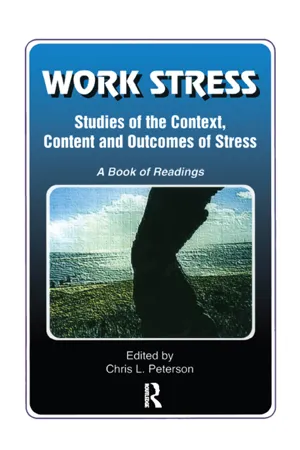Downsizing
Downsizing refers to the process of reducing the size of a company's workforce to cut costs or improve efficiency. This often involves laying off employees or offering voluntary retirement packages. Downsizing can result from various factors such as economic downturns, mergers, or technological advancements, and it can have significant impacts on both the affected employees and the overall organization.
7 Key excerpts on "Downsizing"
- eBook - ePub
The Psychodynamics of Toxic Organizations
Applied Poems, Stories and Analysis
- Howard Stein, Seth Allcorn(Authors)
- 2020(Publication Date)
- Routledge(Publisher)
...5 Downsizing the Workplace For the past three-and-a-half decades, there have been massive dislocations in our public and private organizations that have stripped workers of their jobs and incomes that sustain their sense of worth and their families. Much of this change has been essential to remain competitive. We acknowledge that organizational change is essential to adjust an organization’s structure, methods, and workforce to respond to internal and external opportunities and threats. Changing regulations, actions by competitors, and economic recessions make this essential. At other times, though, some of these changes direct our attention to CEOs desiring to look powerful and in control, as well as “making the numbers” look good at the end of a corporate quarter to improve value for stockholders. The nature of the timing and manner of announcement, we suggest, is often suspect. Beyond the necessity and timing of change is the choice of the methods used to make these often sweeping if not desperate and drastic changes. Downsizing as a method of choice introduces highly destructive outcomes into the lives of their employees, families, and communities. Announcing a Downsizing just before the end of a quarter can make the CEO appear to be in charge and taking control of the bottom line. However, there are other ways to adjust the size and nature of the workforce that are at least as effective—more gradual change that includes retraining and redistributing workers, as well as not making a grand announcement of Downsizing that puts a target on everyone’s back. We also suggest that having to suddenly downsize is not an indication that management has been on the ball, making timely adjustments to keep the organization competitive, the workforce trained, and the organization operating at a level consistent with demands for products and services...
- eBook - ePub
Business
The Ultimate Resource
- Bloomsbury Publishing(Author)
- 2011(Publication Date)
...Downsizing with Dignity by Alan Downs EXECUTIVE SUMMARY • Downsizing is a toxic solution. Used sparingly and with planning it can be an organizational lifesaver, but when used repeatedly without a thoughtful strategy it can destroy an organization’s effectiveness. • One outcome of Downsizing must be to preserve the organization’s intellectual capital. • How downsized employees are treated directly affects the morale and retention of valued, high-performing employees who are not downsized. • Downsizing should never be used as a communication to financial centers or investors of the new management’s tough-minded, no-nonsense style of management—the cost of Downsizing far outweighs any benefits thus gained. INTRODUCTION Make no mistake: Downsizing is extremely difficult, even in challenging financial times. It taxes all of a management team’s resources, including both business acumen and humanity. No one looks forward to Downsizing. Perhaps this is why so many otherwise first-rate executives downsize so poorly. They ignore all the signs pointing to a layoff until it’s too late to plan adequately, then act hastily to reduce the financial drain of excess staff. The extremely difficult decisions of who must be laid off, how much notice they will be given, the amount of severance pay, and how far the company will go to help the laid-off employee find another job are given less than adequate attention. These critical decisions have as much to do with the future of the organization as they do with the future of the laid-off employees, so they must be considered carefully. So what happens? These decisions often are handed to the legal department, whose primary objective is to reduce the risk of litigation, not to protect the morale and intellectual capital of the organization...
- Steven G. Rogelberg(Author)
- 2016(Publication Date)
- SAGE Publications, Inc(Publisher)
...Downsizing Downsizing Wayne F. Cascio Wayne F. Cascio Cascio, Wayne F. 323 326 Downsizing Wayne F. Cascio Downsizing, layoffs, and rightsizing are forms of organizational restructuring. Organizational restructuring refers to planned changes in organizational structure that affect the use of people. Organizational restructuring often results in workforce reductions that may be accomplished through mechanisms such as attrition, early retirements, voluntary severance agreements, or layoffs. The term layoffs is used sometimes as if it were synonymous with Downsizing, but Downsizing is a broad term that can include any number of combinations of reductions in a firm’s use of assets—financial (stock or cash), physical (plants and other infrastructure), human, or informational (databases). Layoffs refer specifically to employment Downsizing. Employment Downsizing, in turn, is not the same thing as organizational decline. Downsizing is an intentional, proactive management strategy, whereas decline is an environmental or organizational phenomenon that occurs involuntarily and results in erosion of an organization’s resource base. As an example, the advent of digital photography, disposable cameras, and other imaging products signaled a steep decline in the demand for the kind of instant photographic cameras and films that Polaroid had pioneered in the 1940s...
- eBook - ePub
Cost Reduction and Control Best Practices
The Best Ways for a Financial Manager to Save Money
- (Author)
- 2012(Publication Date)
- Wiley(Publisher)
...Over time, through the efforts of several government and consulting organizations, an inventory of Downsizing best practices has emerged. Cardinal Rule of Downsizing: Do Not Downsize Only to Reduce Costs In many cases, successful Downsizing depends on what you avoid as well as what you accomplish. In almost any context and over many years, research has shown that across-the-board job cuts undertaken just to reduce payroll expenses, increase profitability, and subsequently, shareholder value, probably will fail over time. Companies that used layoffs solely to cut costs saw a 2% decline in share price, on average, from 30 days before to 90 days after the layoff announcement, according to a 2001–2002 study by Boston-based Bain & Company. Respondents that downsized as part of an overall strategic reorganization plan —”to consolidate a merger and capture business synergies”—however, watched their stock rise an average of 10% during the same time period. That said, grim business reality may leave besieged management with no other choice if they are to keep their companies afloat financially. Conversely, even profitable companies turn to Downsizing to convince investors that they have an ongoing plan for profitability and cost control. Remember that 34% of Lee Hecht Harrison respondents downsized when their organizations were in reasonably sound financial health, but needed to trim the workforce to strengthen their future position. Only 21% downsized because of “difficult financial straits.” To test managers’ assumption that Downsizing will produce improvements in financial performance, Wayne F. Cascio, professor at the Graduate School of Business at the University of Colorado-Denver, and two of his colleagues undertook a study of financial and employment data from Standard & Poor’s 500 companies from 1982 to 1994...
- eBook - ePub
Work Stress
Studies of the Context, Content and Outcomes of Stress: A Book of Readings
- Chris Peterson(Author)
- 2018(Publication Date)
- Routledge(Publisher)
...Downsizing has had considerable effects on all occupational levels, yet more research needs to be conducted to determine appropriate methods for dealing with changing market demands other than simply shedding labor. Downsizing can have particularly stressful consequences and does not necessarily lead to increased productivity and market value for companies; it is one contributor to the wave of increased work intensification. Downsizing needs to be conducted carefully, in a planned and transparent manner, if it is to avoid posing longer-term health, morale, and productivity problems. The moves towards privatization in the public sector in the United Kingdom, United States, and Australia, for example, have also had important effects on the way work is carried out, on job security, and on psychosocial and other health consequences. Privatization has brought with it Downsizing and rationalization of work processes to fit the demands of an open marketplace and has overridden some of the protective work regulations previously in place. It is the effects on stress of these types of work changes that require more study in order to determine the extent to which a changing environment itself precipitates high levels of stress. One commonly reads reports on employees citing too much effort required for the job, too many tasks to perform in short time periods, and an imbalance between work demands and domestic and rest-of-life responsibilities. These pressures and other economic exigencies have forced older employees in some industries to deal with increased stress in the workplace, exacerbated by the demands made by new, increasingly complex technologies...
- eBook - ePub
- David Ryback(Author)
- 2012(Publication Date)
- Routledge(Publisher)
...17 Downsizing and Outsourcing DOI: 10.4324/9780080547534-22 Commerce links all mankind in one common brotherhood of mutual dependence and interests. — PRESIDENT JAMES A. GARFIELD It's one thing to talk about emotional sensitivity, quite another to look cold reality in the face and see the newly disenfranchised in the unemployment lines. The 1990s ushered in a new business philosophy that had never been seen in the history of business— laying off tens of thousands of employees to prune the work force and watch the stock prices climb. Why Downsizing? Companies such as AT&T, IBM and General Motors have laid off 40,000; 120,000; and 74,000 workers, respectively, between 1991 and 1996. Whether these cutbacks are the long-delayed effect of automation, much discussed in the 1950s, or a sacrifice of humans to the greedy gods of Mammon presiding over an insecure Wall Street, they are a reality that cannot be denied. Some argue that these layoffs are a survival mechanism to avoid raids from hostile takeovers, subsequently resulting in the same layoffs in an honest attempt at Downsizing costs. Others argue that eliminating the last vestiges of protectionism by adapting to the legislated North American Free Trade Agreement (NAFTA) makes domestic labor inordinately expensive in the more competitive international marketplace. It is clear by now that Downsizing and outsourcing are more than a mere business fad. They appear to represent a new strategy in response to both long– and short-term economic problems. International Outsourcing As long ago as three or four decades, there were fears that automation and computers might result in the replacement of human labor...
- eBook - ePub
Responsible Restructuring
Creative and Profitable Alternatives to Layoffs
- Wayne F Cascio(Author)
- 2002(Publication Date)
- Berrett-Koehler Publishers(Publisher)
...They all have different skills and add value in different ways. “Downsizing can have a devastating impact on innovation, as skills and contacts that have been developed over the years are destroyed at a stroke.” 19 Knowledge-based businesses, from high-technology firms to the financial services industry, depend heavily on their employees—their stock of human capital—to innovate and grow. They are “learning organizations”—collections of networks in which interrelationships among individuals (i.e., social networks) generate learning and knowledge. This knowledge base constitutes a firm’s “memory.” Downsizing is especially hazardous to learning organizations. Because a single individual has multiple relationships in such an organization, indiscriminate, nonselective Downsizing has the potential to inflict considerable damage on the learning and memory capacity of organizations. 20 That damage is far greater than might be implied by a simple tally of the number of individuals let go. When one considers the multiple relationships generated by one individual, it is clear that restructuring that involves significant reductions in employees can inflict damage and create the loss of significant “chunks” of organizational memory. Such a loss damages ongoing processes and operations, forfeits current contacts, and may lead to foregone business opportunities...






